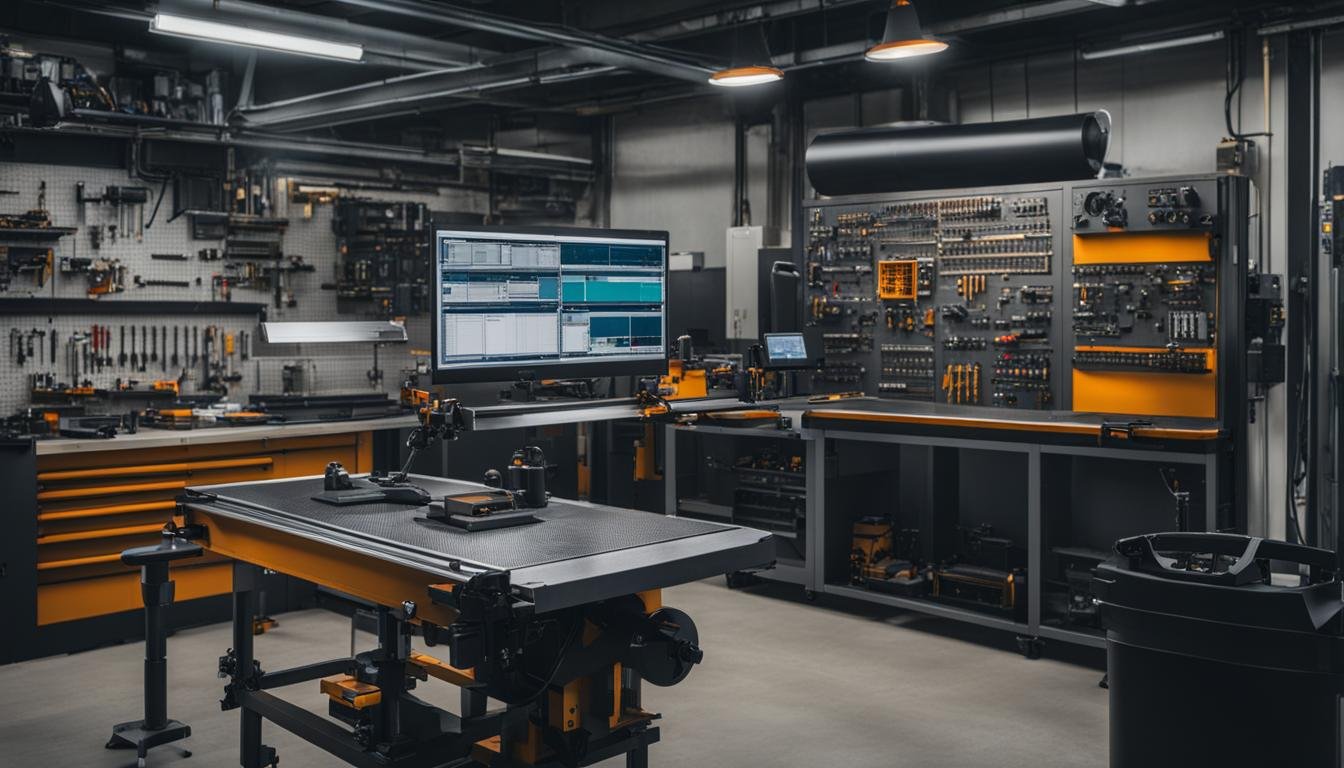CNC machine tools require regular maintenance to ensure optimal performance and longevity. Preventive maintenance is crucial for keeping the machines running smoothly and avoiding costly breakdowns. In this article, we will provide a comprehensive checklist for CNC machine maintenance, covering everything from daily care to yearly maintenance tasks. By following this checklist, you can maximize the efficiency and productivity of your CNC machines, ultimately leading to improved profitability for your company.
Key Takeaways:
- Regular maintenance is essential for the reliability and accuracy of your CNC machine tools.
- Preventive maintenance helps increase profitability, productivity, and machine lifespan.
- Daily and weekly tasks include checking coolant levels, inspecting cutting tools, and ensuring proper cleaning.
- Quarterly and semi-annual maintenance tasks involve in-depth cleaning and inspection.
- Yearly maintenance focuses on accuracy checks and inspections performed by certified professionals.
Why CNC Machine Tool Maintenance is Needed
CNC machine tools are highly reliable and accurate in their machining roles, but they require regular maintenance to ensure their long-term performance. The importance of CNC machine maintenance cannot be overstated, as it not only helps to prevent downtime and accidents but also ensures the machines operate at their full potential.
Regular maintenance of CNC machines brings several benefits. Firstly, it increases profitability by minimizing costly breakdowns and reducing repair costs. Secondly, it improves productivity by preventing unexpected machine failures and minimizing production interruptions. Thirdly, it extends the lifespan of the machine, allowing you to make the most out of your investment. Lastly, it enhances efficiency by maintaining the accuracy and performance of the machine, ultimately leading to better quality products.
By incorporating a program of preventive maintenance, you can maximize the benefits of regular maintenance for your CNC machines. It is crucial to follow the recommended maintenance tasks, such as cleaning, lubricating, and inspecting the machine regularly, as well as performing more in-depth maintenance tasks on a quarterly or semi-annual basis. By doing so, you can ensure that your CNC machine tools remain in optimal condition, resulting in a smoothly running production floor and improved profitability for your company.
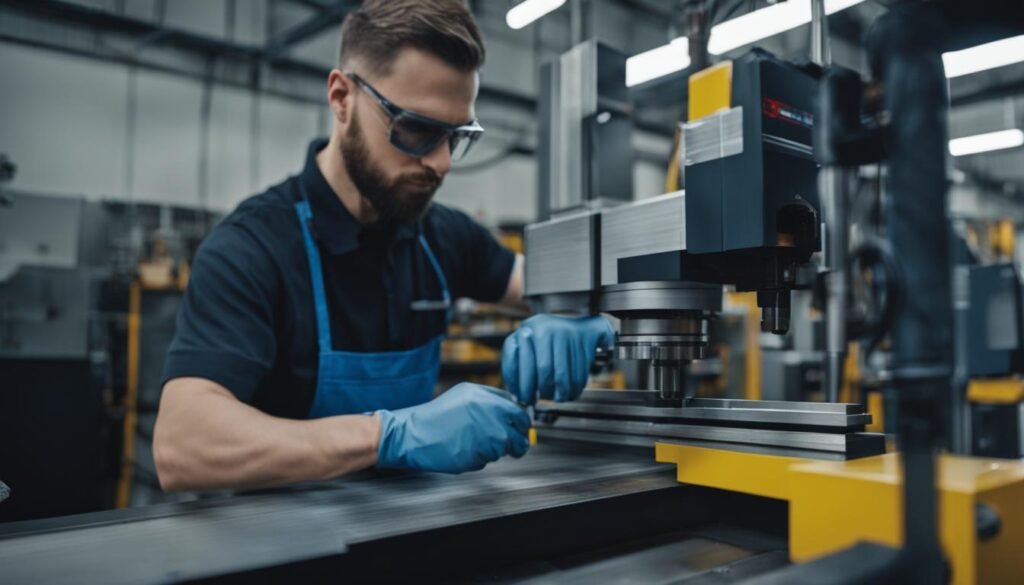
The Importance of CNC Machine Maintenance
“Regular maintenance of CNC machines is essential to ensure their long-term reliability, accuracy, and operational stability. It helps to prevent costly breakdowns, minimize production interruptions, and maintain the overall efficiency of the machines. By incorporating a program of preventive maintenance, you can maximize the benefits of regular maintenance and ensure that your CNC machine tools continue to perform at their best, ultimately leading to improved profitability for your company.”
Daily / Weekly Preventive Maintenance Checklist for Machine Tools
Regular daily and weekly maintenance tasks are essential to ensure the smooth operation of your CNC machines. By performing these routine checks and tasks, you can prevent simple errors that could lead to machine downtime and interruptions in production. Here is a comprehensive checklist of daily and weekly maintenance tasks for your CNC machines:
Checking Coolant Levels
Regularly checking the coolant levels in your CNC machine is crucial for maintaining proper machine performance. Make sure the coolant levels are within the recommended range and top up if necessary. Low coolant levels can lead to overheating and affect the machining accuracy of your CNC machine.
Inspecting Cutting Tools
Inspecting the cutting tools is an important daily task to ensure their sharpness and effectiveness. Check for any signs of wear or damage, such as dull edges or chipped tips. Replace any worn-out or damaged cutting tools to maintain optimal machining quality.
Checking Hydraulic Systems for Leaks
Inspect the hydraulic systems of your CNC machine for any signs of leaks or fluid loss. Hydraulic leaks can lead to a drop in machine performance and, if left unaddressed, can result in serious damage to your CNC machine. Be sure to address any leaks promptly and replace any faulty components.
Ensuring Clean and Dry Air Supply
A clean and dry air supply is essential for the proper functioning of your CNC machine. Check the air supply filters regularly and clean or replace them as needed. Moisture and contaminants in the air can affect the performance and accuracy of your machine, so it’s important to maintain a clean and dry air supply.
Lubricating Moving Parts
Lubricating the moving parts of your CNC machine is vital to prevent friction and wear. Use the recommended lubricants and follow the manufacturer’s guidelines for lubricating different components. Regular lubrication will help extend the lifespan of your machine and ensure smooth operation.
Proper Cleaning of Chips
Chips and debris can accumulate in the machine during operation, affecting its performance. Regularly clean the chips and debris from the machine using appropriate cleaning tools and methods. This will prevent clogs and ensure efficient machining processes.
Checking Pneumatic Pumps
Inspect the pneumatic pumps of your CNC machine to ensure they are functioning properly. Check for any signs of leaks, unusual noises, or fluctuations in pressure. Address any issues promptly to avoid disruptions in the pneumatic system and maintain optimal machine performance.
| Daily / Weekly Preventive Maintenance Checklist |
|---|
| Checking Coolant Levels |
| Inspecting Cutting Tools |
| Checking Hydraulic Systems for Leaks |
| Ensuring Clean and Dry Air Supply |
| Lubricating Moving Parts |
| Proper Cleaning of Chips |
| Checking Pneumatic Pumps |
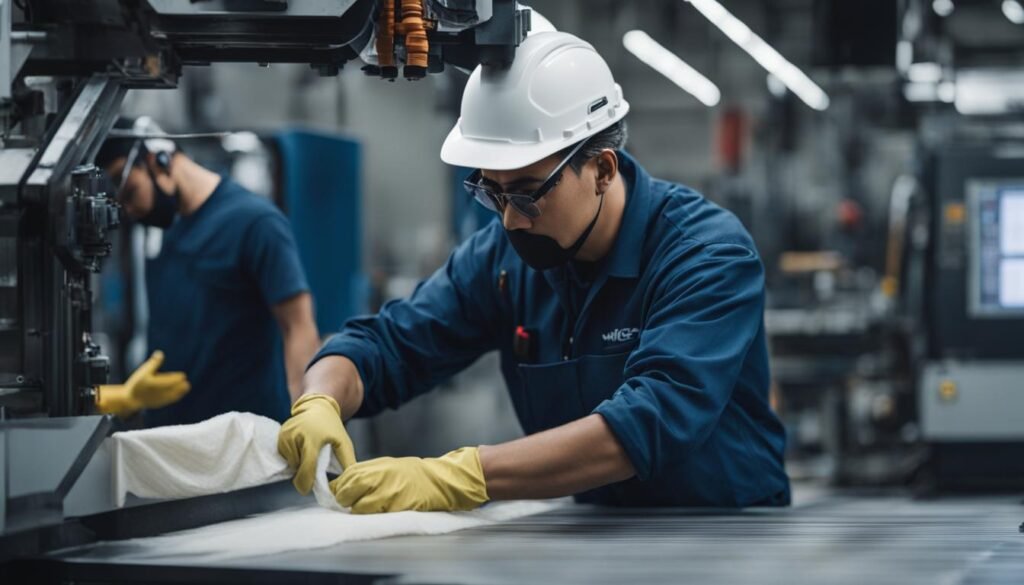
Quarterly / Semi-Annual Maintenance Checklist for Machine Tools
Regular maintenance is vital for the optimal performance and longevity of your CNC machines. In addition to the daily and weekly maintenance tasks covered in the previous section, there are more in-depth tasks that should be performed on a quarterly or semi-annual basis. These tasks go beyond routine checks and help identify and address any potential issues before they escalate into major breakdowns.
Here is a comprehensive checklist of quarterly and semi-annual maintenance tasks for your CNC machine tools:
| Task | Description |
|---|---|
| Cleaning Coolant Tanks | Remove any sludge or debris from the coolant tanks and ensure proper coolant levels are maintained. |
| Checking and Cleaning Filters | Inspect and clean or replace filters to ensure proper filtration of coolant and lubrication systems. |
| Cleaning the Hydraulic Tank | Remove any contaminants from the hydraulic tank and check for any leaks or damage. |
| Replacing Hydraulic Oil and Filters | Drain and replace the hydraulic oil and filters to maintain proper lubrication and prevent component wear. |
| Inspecting and Cleaning the Radiator | Check the radiator for any clogs or damage, clean any debris, and ensure efficient cooling of the machine. |
| Inspecting and Replacing Way Wipers | Check the condition of way wipers and replace if worn or damaged to maintain smooth movement of machine components. |
| Drain and Clean the Lubrication Unit | Remove old lubricant, clean the lubrication unit, and refill with fresh lubricant to ensure proper lubrication of moving parts. |
| Checking and Refilling the Cooling Unit | Inspect the cooling unit, check coolant levels, and top up if necessary to prevent overheating of the machine. |
| Checking Machine Leveling | Ensure the machine is properly leveled to maintain accuracy and prevent undue stress on components. |
By following this checklist and performing these tasks on a quarterly or semi-annual basis, you can minimize the risk of major breakdowns, prolong the lifespan of your CNC machines, and ensure they continue to operate at their best.
Yearly Maintenance Checklist for Machine Tools
Performing a comprehensive annual maintenance check for your CNC machines is essential to ensure their accuracy and functionality. By following this yearly maintenance checklist, you can identify any issues and address them promptly, preventing major breakdowns and optimizing the performance of your machines.
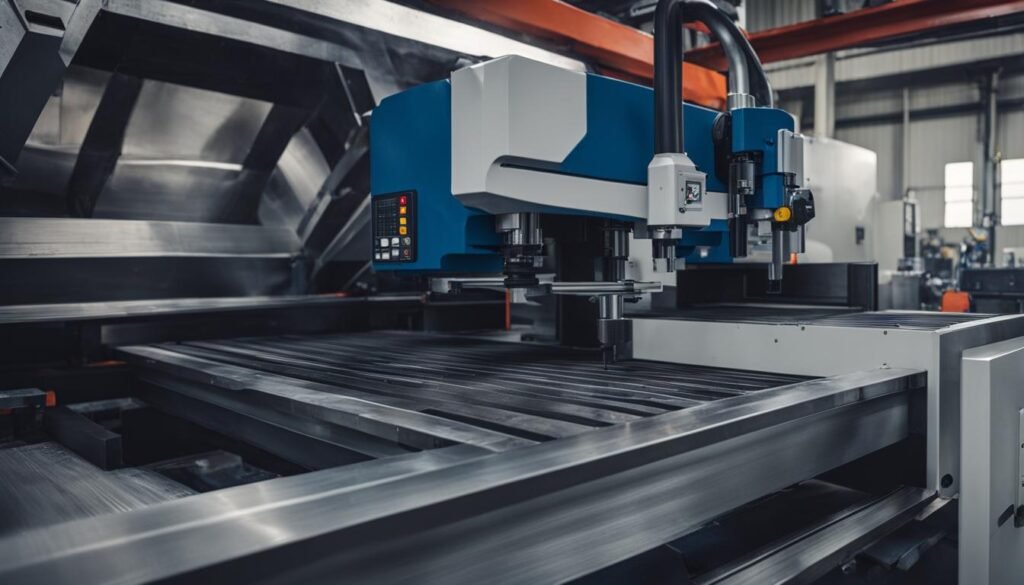
Machine Tool Accuracy Check
Checking the accuracy of your machine tools ensures that they perform their machining roles with precision. It involves inspecting various components and measurements to ensure that they meet the required tolerances. Some key accuracy checks to perform include:
- Checking the spindle for radial and end play issues
- Checking the chuck cylinder for runout
- Inspecting the tailstock for misalignments
- Checking the turret parallelism and inclination
- Inspecting the machine for oil or air leaks
- Checking the headstock for damage or misalignments
- Testing the spindle taper at milling machines
Machine Tool Level Check
Ensuring that your machine tools are properly leveled is crucial for their stability and accuracy. A machine that is not level can lead to uneven cutting, poor surface finish, and increased wear on the machine components. To perform a level check, use precision leveling tools and adjust the machine’s feet or leveling pads as necessary until it is perfectly level.
By conducting these yearly maintenance tasks and addressing any issues that arise, you can maintain the accuracy, functionality, and longevity of your CNC machines. It is recommended to have these tasks performed by well-trained and certified professionals to ensure accurate results and minimize the risk of errors.
| Task | Description |
|---|---|
| Machine Tool Accuracy Check | Inspect and measure components to ensure accuracy |
| Spindle Check | Check for radial and end play issues |
| Chuck Cylinder Check | Inspect for runout |
| Tailstock Inspection | Ensure proper alignment |
| Turret Check | Inspect parallelism and inclination |
| Machine Inspection | Check for leaks and damage |
| Spindle Taper Testing | Test taper accuracy at milling machines |
| Machine Tool Level Check | Ensure the machine is properly leveled |
Tips for Effective CNC Machine Preventive Maintenance
Implementing a proactive approach to CNC machine maintenance can significantly enhance the performance and longevity of your equipment. Follow these tips to ensure effective preventive maintenance for your CNC machines:
1. Schedule Maintenance in Alignment with Equipment Needs
Coordinate maintenance tasks with your production schedule to minimize downtime and disruption. Avoid performing critical maintenance during peak production times and instead schedule it during periods of lower demand or planned machine downtime. By aligning maintenance with equipment needs, you can optimize the efficiency of your CNC machines and maintain uninterrupted production.
2. Establish a Worker Check System
Create a system that encourages machine operators to report any potential issues or abnormalities. Empower your workers to be vigilant during their daily tasks and provide a clear process for reporting machine problems. This proactive approach allows for early detection of potential maintenance issues, helping to prevent costly breakdowns and minimize production delays.
3. Source Spare Parts Ahead of Time
Maintaining a stock of commonly used spare parts ensures that you have the necessary components on hand when needed. Identify the critical parts that may wear out or require replacement regularly and keep a sufficient inventory. This approach allows for timely repairs and reduces machine downtime, maximizing your CNC machines’ productivity.
4. Maintain Accurate Maintenance Records
Keeping detailed maintenance records is crucial for effective CNC machine maintenance. Documenting maintenance tasks, repairs, and inspections provides valuable historical data for future reference. Accurate records help in tracking the performance of your machines, identifying trends or recurring issues, and making informed decisions about equipment upgrades or replacements.
Implementing these preventive maintenance tips, in addition to following a comprehensive maintenance checklist, will help ensure the optimal performance and reliability of your CNC machines. By proactively addressing maintenance needs, you can minimize downtime, reduce repair costs, and maximize the efficiency and longevity of your equipment.
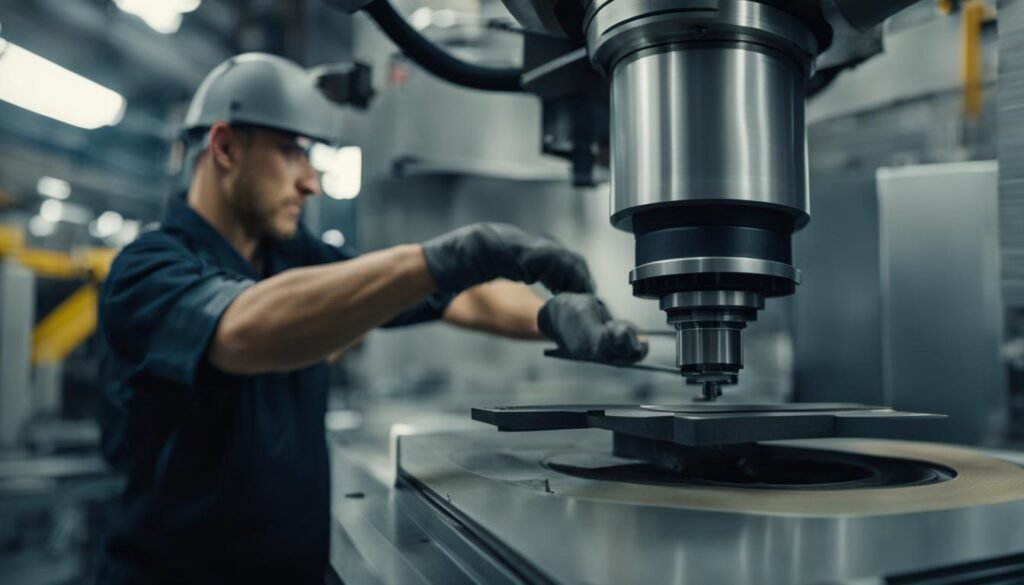
The Importance of Keeping CNC Machines Clean
Regular cleaning and maintenance of CNC machines are essential for their optimal performance and longevity. By keeping your machines clean and well lubricated, you can prevent debris buildup, minimize wear and tear, and ensure accurate machining results. Here are some best practices for cleaning and maintaining CNC machines:
1. Daily Cleaning Routine
Develop a daily cleaning routine that includes wiping down all machine parts, removing chips and debris, and cleaning the viewing windows. Use appropriate cleaning agents and tools to ensure thorough cleaning without damaging the machine. Regularly check and clean the coolant tank and filters to maintain coolant quality.
2. Lubrication
Proper lubrication is crucial for smooth machine operation and prolonging the lifespan of moving parts. Follow manufacturer recommendations for lubrication intervals and use the recommended lubricants. Ensure that all lubrication points are adequately greased and periodically check for any leaks or abnormalities.
3. Regular Maintenance Inspections
In addition to daily cleaning, schedule regular maintenance inspections to identify any potential issues or wear and tear. Check for loose or worn-out belts, inspect the spindle for any radial or end play issues, and ensure proper alignment of the machine components. Keeping up with these inspections will help identify and address problems before they escalate.
4. Safety First
When cleaning CNC machines, always prioritize safety. Ensure the machine is turned off and disconnected from the power source before starting any cleaning or maintenance tasks. Follow proper lockout/tagout procedures to prevent accidental machine startup. Wear appropriate personal protective equipment (PPE) such as gloves, safety glasses, and masks when handling cleaning agents or operating the machines.
5. Documentation
Maintain detailed records of all cleaning and maintenance activities, including dates, tasks performed, and any observations or issues encountered. This documentation will serve as a reference for future maintenance and help track the overall condition of the machines. It can also be helpful for warranty claims or when seeking professional maintenance assistance.
Keeping CNC machines clean and well-maintained is crucial for their optimal performance, accuracy, and longevity. By following these best practices, you can ensure that your machines continue to operate at their best, minimizing downtime and maximizing productivity.
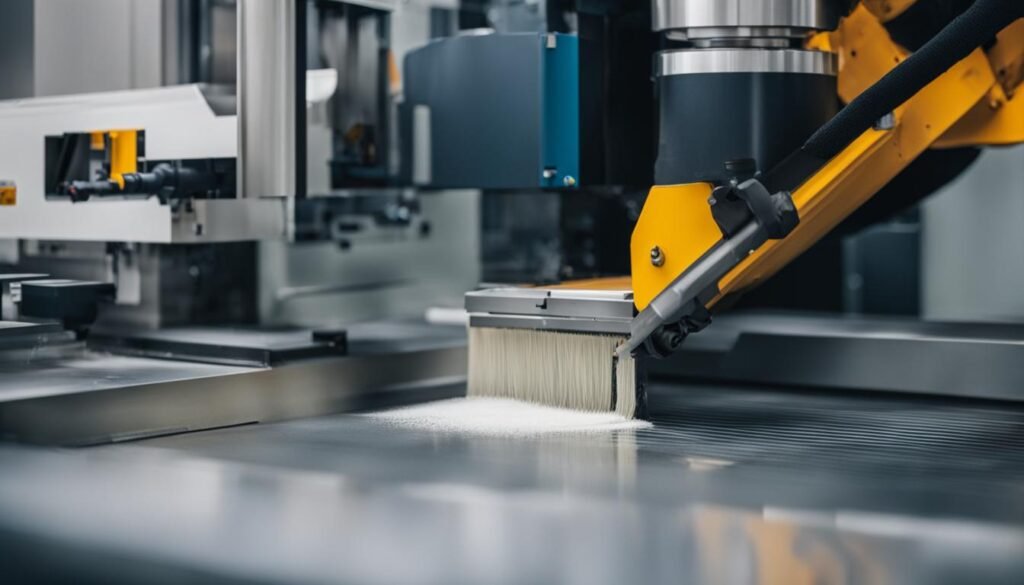
Establishing a Routine Maintenance Schedule
To effectively implement preventive maintenance for your CNC machines, it is crucial to establish a routine maintenance schedule. By scheduling and conducting regular maintenance tasks, you can minimize the risk of unexpected breakdowns, maximize machine uptime, and ensure the longevity of your equipment.
Creating a maintenance schedule involves identifying the specific tasks that need to be performed at different intervals. This can include daily, weekly, quarterly, semi-annual, and yearly maintenance tasks. By breaking down the maintenance requirements into manageable intervals, you can ensure that each task is given the necessary attention.
Benefits of Creating a CNC Machine Maintenance Schedule
- Prevents breakdowns: By proactively addressing maintenance needs, you can identify and resolve potential issues before they escalate into major breakdowns that can lead to costly production downtime.
- Maximizes machine uptime: Regular maintenance ensures that your CNC machines are consistently operating at their peak performance levels, reducing the chances of unexpected downtime that can negatively impact productivity.
- Prolongs machine lifespan: Well-maintained machines last longer, saving you money on premature replacements and allowing you to maximize the return on your investment.
- Optimizes performance: Routine maintenance tasks such as cleaning, lubricating, and aligning ensure that your machines are operating at their optimal levels, resulting in improved accuracy, efficiency, and overall performance.
When creating a maintenance schedule, consider factors such as the workload of your CNC machines, the manufacturer’s recommendations, and the specific requirements of your production processes. It is also important to involve your machine operators and maintenance personnel in the process, as they have valuable insights into the machines’ day-to-day performance and maintenance needs.
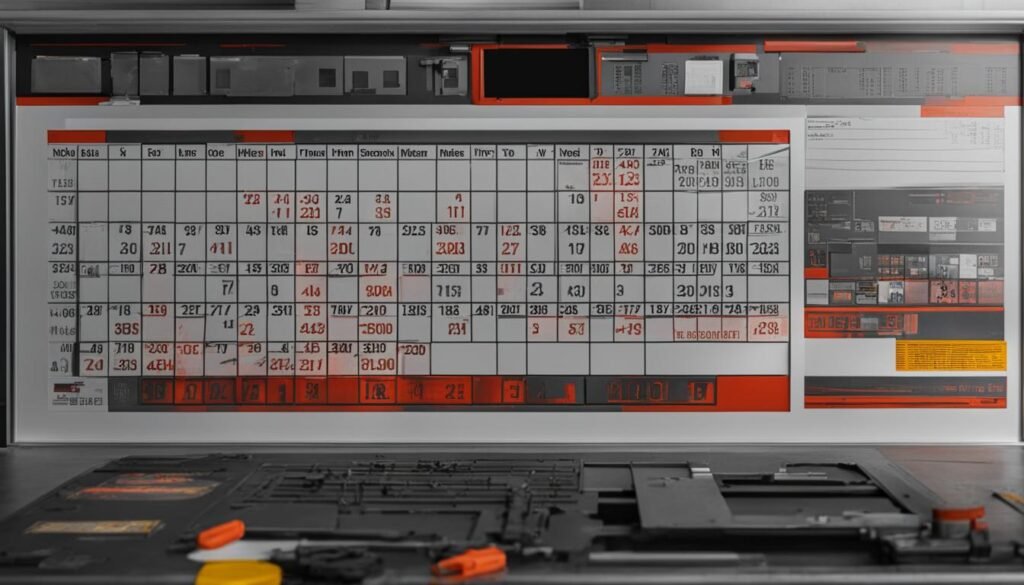
| Maintenance Interval | Tasks |
|---|---|
| Daily |
|
| Weekly |
|
| Quarterly |
|
| Semi-Annual |
|
| Yearly |
|
By incorporating a routine maintenance schedule, you can effectively manage and prioritize the maintenance needs of your CNC machines. This will not only ensure the smooth operation of your equipment but also contribute to the overall efficiency and profitability of your manufacturing processes.
Maintaining Accurate Maintenance Records
Keeping accurate maintenance records is crucial for the effective maintenance of your CNC machines. These records serve as a valuable reference for future maintenance tasks, enabling you to plan resources and tools needed for maintenance efficiently. Additionally, maintenance records provide a baseline for assessing equipment performance, allowing you to identify patterns or recurring issues that may require further attention.
By documenting maintenance processes and findings, you can make informed decisions about when to replace parts or upgrade equipment. Regularly reviewing your maintenance records and analyzing the data can help you identify trends, improve maintenance practices, and optimize machine performance. Whether it’s tracking the frequency of certain maintenance tasks or noting the lifespan of different machine components, accurate records provide valuable insights that support proactive maintenance planning.
Furthermore, maintaining detailed maintenance records is essential for compliance purposes. Depending on the industry, you may be required to keep records of maintenance activities to ensure regulatory compliance and provide evidence of adherence to industry standards. In the event of an audit or inspection, having comprehensive maintenance records readily available can save time and demonstrate your commitment to maintaining high-quality standards.
The Benefits of Accurate Maintenance Records:
- Facilitate proactive maintenance planning
- Identify recurring issues and patterns
- Optimize machine performance and efficiency
- Support compliance with industry regulations
- Provide evidence of adherence to maintenance protocols
- Enable effective decision-making for part replacements and upgrades
By prioritizing the maintenance of accurate records, you can ensure the long-term reliability and performance of your CNC machines, minimize downtime, and maximize overall operational efficiency.
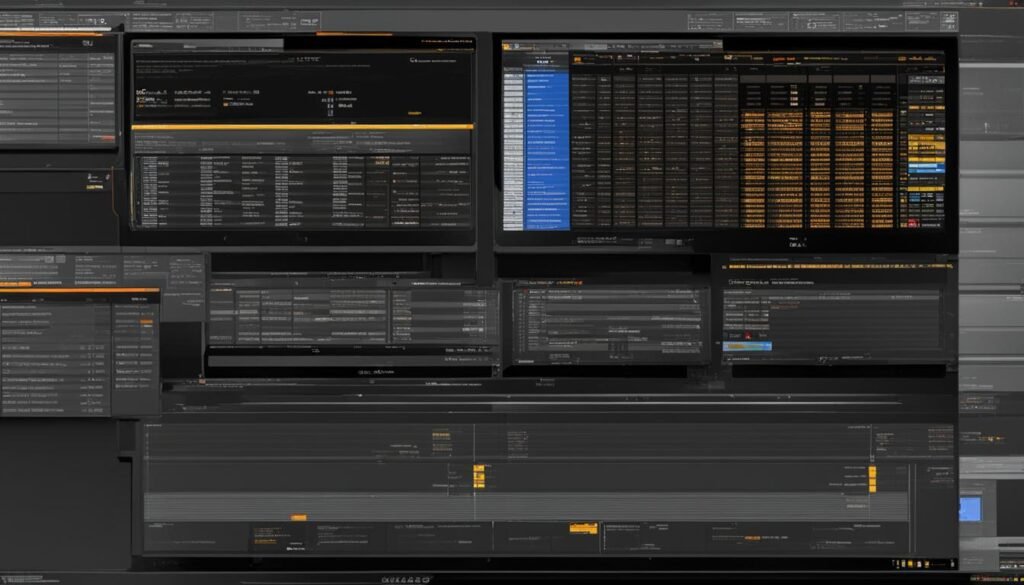
Reference
“Accurate maintenance records are crucial for ensuring the long-term reliability and performance of your CNC machines.”
Conclusion
In conclusion, proper maintenance is essential for the optimal performance and longevity of your CNC machines. By following a comprehensive maintenance checklist, establishing a routine maintenance schedule, and keeping accurate records, you can ensure that your machines operate at their best. Regular cleaning and lubrication also play a vital role in maximizing efficiency and preventing breakdowns.
Implementing preventive maintenance measures not only increases productivity and profitability but also extends the lifespan of your CNC machines. By taking proactive steps to care for your equipment, you can minimize downtime, reduce repair costs, and maintain the accuracy and reliability of your machines.
Remember, preventive maintenance is an ongoing process that requires consistent attention and dedication. By prioritizing maintenance tasks, you can avoid costly breakdowns and ensure that your CNC machines continue to deliver exceptional performance, ultimately benefiting your company’s bottom line. For more information and expert guidance on optimizing your CNC machine maintenance, feel free to contact us.
FAQ
Why is regular maintenance important for CNC machine tools?
Regular maintenance is crucial for ensuring optimal performance, longevity, and accuracy of CNC machine tools. It helps prevent breakdowns, minimize downtime, and reduce repair costs, ultimately leading to improved profitability and productivity.
What are some daily and weekly maintenance tasks for CNC machines?
Some daily and weekly maintenance tasks include checking coolant levels, inspecting cutting tools, checking hydraulic systems for leaks, ensuring clean and dry air supply, lubricating moving parts, cleaning chips, and checking pneumatic pumps.
What are some quarterly or semi-annual maintenance tasks for CNC machines?
Quarterly or semi-annual maintenance tasks include cleaning coolant tanks, checking and cleaning filters, cleaning the hydraulic tank, replacing hydraulic oil and filters, inspecting and cleaning the radiator, inspecting and replacing way wipers, draining and cleaning the lubrication unit, checking and refilling the cooling unit, and checking the machine leveling.
What are some yearly maintenance tasks for CNC machines?
Yearly maintenance tasks include checking the spindle for radial and end play issues, checking the chuck cylinder for runout, inspecting the tailstock for misalignments, checking the turret parallelism and inclination, inspecting the machine for oil or air leaks, checking the headstock for damage or misalignments, and testing the spindle taper at milling machines.
What are some tips for effective CNC machine preventive maintenance?
Some tips for effective preventive maintenance include scheduling maintenance to coincide with equipment needs, establishing a worker check system to report machine problems, sourcing spare parts ahead of time, maintaining accurate maintenance records, and considering the replacement of old equipment when necessary.
How important is it to keep CNC machines clean?
Keeping CNC machines clean is essential to prevent debris buildup and ensure optimal machine performance. Regular cleaning of all machine parts, including viewing windows, cutters, spindles, tool holders, and fixtures, is recommended.
How can I establish a routine maintenance schedule for my CNC machines?
To establish a routine maintenance schedule, include tasks such as cleaning, lubricating, replacing worn parts, checking alignments, and inspecting machine levels. By scheduling maintenance tasks and adhering to the schedule, you can minimize breakdowns and maximize machine uptime.
Why is it important to maintain accurate maintenance records for CNC machines?
Accurate maintenance records serve as a reference for future maintenance tasks, help in planning resources and tools needed for maintenance, and provide a baseline for assessing equipment performance. They are crucial for ensuring the long-term reliability and performance of CNC machines.
